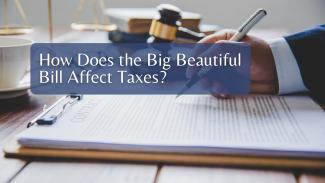
OBBBA: More about Deductions — QBI Deduction Changes for Business Owners & New Deductions that Don’t Require Itemizing
Business Owners: What’s Changing (and Staying) in the QBI Deduction
The 20% QBI Deduction Survives — With a Slightly Bigger Safety Net
If you're a business owner or earn income through a pass-through entity (like an LLC, S corp, or partnership), the Qualified Business Income (QBI) deduction has been one of the most valuable tax benefits around. OBBBA keeps it largely intact — but adds a few wrinkles.
What’s Staying the Same:
• You can still deduct 20% of qualified business income from eligible pass-through businesses.
• The phaseout rules for Specified Service Trades or Businesses (SSTBs) — like doctors, consultants, and financial advisors — remain.
What’s Changing (Starting in 2026):
1. Wider Phaseout Ranges
If you're in an SSTB and earn above $197,300 (single) or $394,600 (joint), your deduction starts phasing out. Under OBBBA, that phaseout range gets wider — meaning more higher-income professionals may keep a partial deduction.
2. $400 Minimum Deduction
Taxpayers with at least $1,000 of active business income now qualify for a minimum $400 QBI deduction — even if 20% of their income wouldn’t otherwise meet that threshold.
💡 Tax Planning Tip:
If you’re hovering around the phaseout zone, proactive planning — like retirement plan contributions, business income deferral, or entity restructuring — could help you stay eligible.
📌 Deadline: These changes take effect January 1, 2026, so your 2025 income will be the final year subject to current phaseout rules.
🚨 Key Detail: Consider accelerating income or deductible business expenses into 2025 if the current rules are more favorable to your situation. Conversely, if you’re close to the new 2026 thresholds, early projections can help you avoid surprises next year.
The key takeaway? The deduction is still here, but as your income rises, it pays to double-check how much you're really eligible to claim — and when the best time is to recognize that income. Most of the strategies we’ve discussed so far in our review of OBBBA would involve conferring with your CPA. For QBI, the calculations can be complicated, so please be sure to contact your tax advisor.
Next Up: We’ll shift gears into five new deductions created under OBBBA — all available below the line, even if you don’t itemize.
New Tax Breaks for Tips, Overtime, Auto Loans & More
Don’t Itemize? You Can Still Claim These New Deductions
OBBBA introduced several new “below-the-line” deductions — and here’s the best part: you don’t have to itemize to claim them.
These apply from 2025 through 2028 and could benefit a wide range of taxpayers — including retirees, hourly workers, and younger families.
1. $6,000 Deduction for Age 65+
We covered this in an earlier posting, but it’s worth a reminder: if you're 65 or older, you may qualify for an extra $6,000 deduction ($12,000 for couples), even if you take the standard deduction.
📌 Effective Starting: January 1, 2025
🚨 Income Phaseout: Begins at $75K single / $150K joint MAGI; fully phased out at $175K / $250K
2. Up to $25,000 Deduction for Tips
If you work in a tipping-based occupation (restaurants, salons, etc.), you may deduct up to $25,000 of qualified tip income.
🚨 Key Details:
• Income Phaseout: Begins at $150,000 MAGI (single) / $300,000 (joint)
• Ineligible Professions: Attorneys, advisors, and accountants cannot claim this
• Deadline: Tip income must be earned and reported in 2025–2028 calendar years
3. Deduction for Overtime Pay
You can also deduct the extra portion of your qualified overtime compensation:
• Up to $12,500 (single) or $25,000 (joint)
• To be “Qualified”, the income can only include the extra part of the earned hourly rate. For example, if a worker earns $20/hr for their regular work week and $30/hr for overtime hours, the extra $10/hr is the qualified portion.
🚨 Key Details:
• Same phaseouts apply as do for tips
• Must be wages earned in the 2025–2028 period
4. Auto Loan Interest Deduction
If you buy a new, U.S.-assembled vehicle in 2025 or later, the interest on that loan could be deductible — up to $10,000 per year.
Applies To:
• New cars, trucks, SUVs, and motorcycles
• Vehicle must be U.S.-assembled
• Does not apply to used vehicles or RVs
🚨 Income Phaseout: Over $100K (single) / $200K (joint)
💡 Planning Tip: If you're shopping for a new vehicle, purchase and financing must happen in 2025 or later to qualify.
Under the, “What were they thinking?” category, to incur $10,000 of interest on a car loan at current 7% rates, you would have to spend almost $143,000 for one car or buy two $70,000+ cars in the same year. That doesn’t make much sense if the availability of this deduction for individuals starts to phase out at $100K.
5. Charitable Deduction for Non-Itemizers
Itemizing is no longer required to get a break for giving:
• Starting in 2026, you can deduct up to $1,000 (single) or $2,000 (joint) for qualifying cash donations — even if you take the standard deduction.
📌 Effective Starting: January 1, 2026
🚨 Planning Note: If your charitable giving in 2025 is modest, you might want to spread some into 2026 to capture this new non-itemizer benefit.
Takeaway: These deductions may not apply to everyone, but they add new flexibility and planning opportunities — especially for middle-income households or retirees managing income levels around deduction thresholds.
Next Up: We’ll cover child-related credits, AMT changes, and estate planning updates that may affect your longer-term strategy.

